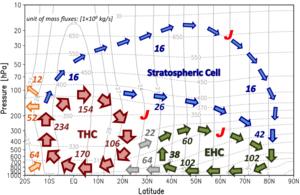(i) The systematic downward propagation of geopotential height and zonal wind anomalies in the extratropics;
(Kodera and Kuroda 1990; Baldwin and Dunkerton 1999; Baldwin and Dunkerton 2001; Cai and Ren 2007; Ren and Cai 2007)
(ii) The delayed feedbacks of the stratosphere to the upward propagation of tropospheric Rossby waves;
(Hartley et al. 1998; Limpavusan and Hartmann 2000; Ambaum and Hoskins 2002; Polvani and Waugh 2004; Kuroda 2008)
(iii) The downward control principle and with transient eddy feedbacks;
(Haynes et al. 1991; Song and Robinson 2004)
(iv) The reflection of planetary waves;
(Perlwitz and Harnik 2003)
(v) The invertibility principle of potential vorticity.
(Hartley et al. 1998)

Figure 1. Atmospheric meridional mass circulation in isentropic levels. The mass circulation quantifies the net transport of air mass of different entropy in a given latitude band. Solid contours and numbers indicate the winter DJF mean mass transport (units: 109 kg s-1) in each branch of the mass circulation and dashed contours indicate the isentropic levels (units: K) in pressure coordinate. By definition, mass transport along isentropic level is purely due to adiabatic processes, and mass transport across isentropic levels is due to diabatic heating/cooling. (Johnson 1989; Cai and Shin 2014)

